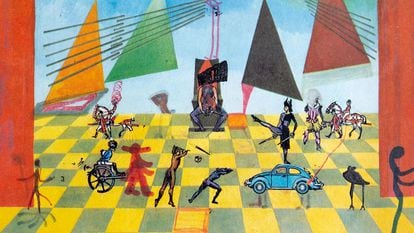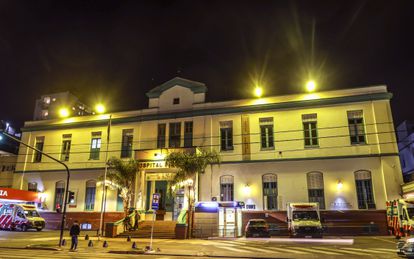/cloudfront-eu-central-1.images.arcpublishing.com/prisa/YGHQEFFJ4BFGNKZFHQJOPIVMZM.jpeg) |
| Alejandra Pizarnik |
Alejandra Pizarnik: ‘I write against fear’
Fifty years after she took her own life at age 36, Argentina pays tribute to its legendary poet
Mar Centenera
Buenos Aires, September 26, 2022
Fifty years after her passing, Argentina is paying tribute to one of its biggest cultural figures with exhibitions, seminars and recitals of poems whose admirers included literary giants such as Octavio Paz and Julio Cortázar. Her legend continues to grow, fed by unpublished material that continues to be released, bit by bit, and adds nuance to her image as a tragic poet by showing another side of her as an ironic, irreverent woman who was a feminist and a fan of the visual arts

“In a lost town: Ojos Alba,” (1970), a collage by Pizarnik on display in the National Library of Argentina.
“Who was Pizarnik in reality? The polygrapher of “pure words” and forger of her own legend? Or the existential, pornographic, tremendous writer who managed to hide certain aspects of her life and work?” Patricia Venti asks in Alejandra Pizarnik: Biography of a myth, the most extensive book about the poet’s life. To find answers, literary scholars Venti and Cristina Piña delved into Pizarnik’s papers – held at Princeton University – and interviewed her friends and family.
Flora Pizarnik – the future Alejandra – was born in Avellaneda, on the outskirts of Buenos Aires, on April 29, 1936. She was the second daughter of Russian Jews who had fled Europe two years earlier. Migrating saved their lives: the relatives who stayed behind were massacred by the Nazis and the Soviets. Pizarnik was too young to understand the horrors that chased her parents across the Atlantic, but that darkness that she could feel at home marked her early years. Childhood later became one of the central elements of her poetry:
“I don’t know about childhood
more than a luminous fear
and a hand that drags me to my other shore.
My childhood and its perfume
a caressed bird.”
Pizarnik began college studies in philosophy, switched to journalism, then again to literature. She also tried painting. She eventually abandoned her studies, dedicating herself fully to writing. She also discovered a fondness for pills: the first ones were to help her lose weight, but she realized that they also gave her lucidity on the nights devoted to her notebooks.
“Pizarnik took pills for everything. To sleep, to wake up,” says Piña, her main biographer. “From a certain point in her life, she became a living cocktail of pills and, evidently, there was a deepening deterioration.”
She was 19 years old when she published The Most Foreign Country (1955) – her first book of poems, which she later disowned. It was followed by A sign in your shadow (1955), The last innocence (1956) and The lost adventures (1958). In 1960, the emerging poet travelled by ship to Paris, where she spent the happiest years of her life, surrounded by Latin American writers and devoted to the verses of her masterpiece, Diana’s Tree. It was published in 1962, with a laudatory foreword by the Mexican poet Octavio Paz, who would go on to win the Nobel Prize for Literature.
Those who knew Pizarnik remember how she battled with language until she had found the exact words. “I [never] met anyone capable of doing what she did with Spanish,” says the poet and essayist Ivonne Bordelois, Pizarnik’s close friend.
“I change words, delete verses. Sometimes, by deleting a word, I imagine another one in its place, but without knowing its name yet. So, while waiting for the desired one, I make a drawing in [the] emptiness that alludes to it,” Pizarnik wrote in a fragment of her notebooks.
She devoted her life to writing, but never stopped drawing. In the margins of her books, she made what she described as “elementary and cathartic, childish and clumsy” drawings. Pizarnik played with irony, reversing the idea of tragic myth. Her sense of humor appears recurrently in testimony by her friends:
“Our friendship happened because I was always serious and she was always joking. I liked what she said jokingly, and she liked what I said seriously,” recalled the Argentine writer Elvira Orpheé.
Her humor, however, is subtle, buried under layers of fear and anguish. In her poem Primitive Eyes, she penned these verses:
“I write against fear.
Against the wind with claws
that lodge in my breath.”
Pizarnik’s love life has mostly gone undiscussed, although the biography by Piña and Venti explores her bisexuality. She had a teenage relationship with the lawyer and writer Juan Jacobo Bajarlía and a romance in Paris with the Colombian poet Jorge Gaitán Durán, which was cut short by his death in a plane crash in 1962. She also had a relationship with the photographer and translator Marta Moia. Her last great passion was the Argentine writer Silvana Ocampo – they would spend hours talking on the phone.
Her diaries reveal that she had a clandestine abortion as a result of a relationship “with C., in a perfect state of intoxication,” according to an entry from September 1963. “Each one is the owner of their own body, each one controls it as they want and as they can,” she replied to a question about her abortion in 1970.

The death of her father in 1966 and her brief return to Paris – no longer the city of light – severely impacted Pizarnik. She attempted suicide in 1970 and again in 1971. She was admitted to a psychiatric ward, an experience she wrote about in her poem Psychopathology Room:
“And since I am so intelligent that I am no longer good for anything
and since I have dreamed so much that I am no longer of this world
here I am, among the innocent souls of Room 18
persuading myself day by day
that the room, the pure souls and I have meaning, we have destiny.”
On September 25, 1972, she received permission from the hospital to go stay at home for the weekend. After calling some friends – even making plans to go to the movies with one – she took her own life. On the blackboard in her bedroom, she put down some final verses:
“I do not want to go
anywhere else
than to the bottom.”
EL PAÍS


No comments:
Post a Comment